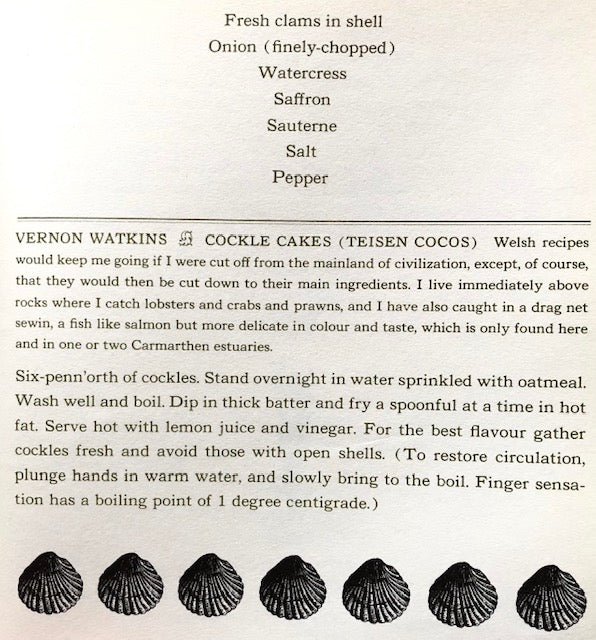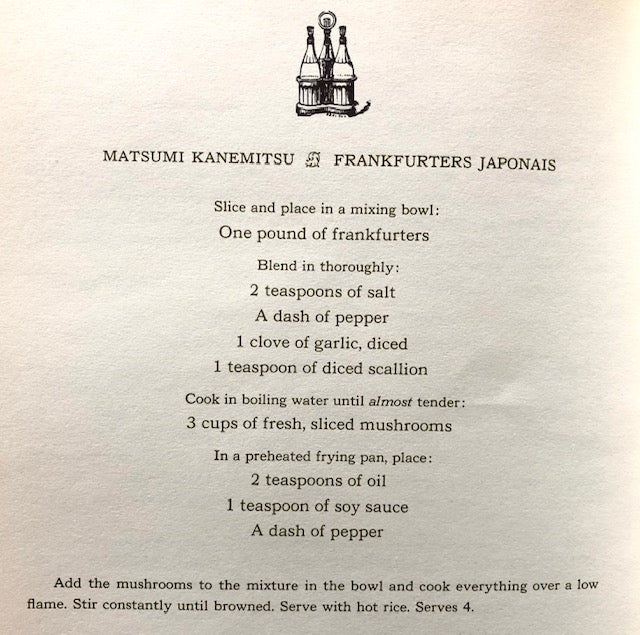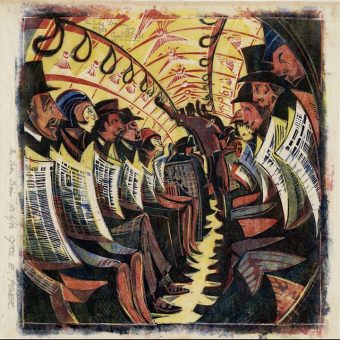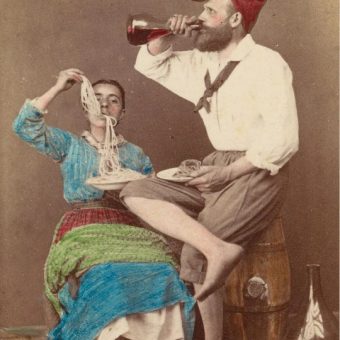First published in 1961, The Artists’ & Writers’ Cookbook shares 220 recipes by 55 painters, 61 novelists, 15 sculptors and 19 poets. Dedicated to the art of imperfection in the kithc”, it’s a fun book in which wit and wine feature heavily.
American novelist William Styron delivers a six-page-long recipe for Southern fried chicken, a dish which he describes as the “most put-upon, abused and generally misunderstood of all indigenous American culinary triumphs”. English poet John Keats (31 October 1795 – 23 February 1821) offers a breakfast menu of cider-flavoured cauliflower, toasted French bread with garlic butter, and sausage prepared in wine. Keats thought breakfast “should be regarded as a time of joy, of new beginnings”. He also loved elevenses, lunch, tea and dinner:
“People like dogs, should not be fed more than twice a day. Any diet that includes three squares invariably produces round folk of fat and flatulence…”

The book was designed by illustrator Nicolas Sidjakov (December 16, 1924 – June 20, 1993) with engravings from the 19th century and drawings by Marcel Duchamp, Robert Osborn and Alexandre Istrati.
Things began with a forward by Alice B. Toklas (April 30, 1877 – March 7, 1967) and a recipe for an omelette that George Sand (1 July 1804 – 8 June 1876) once sent her fellow novelist Victor Hugo (26 February 1802 – 22 May 1885) – which may or may not go well after a serving of Alice’s hashish fudge:
Alice B. Toklas’s Omelette Aurore
Beat 8 eggs with a pinch of salt, 1 tablespoon sugar and 3 tablespoons heavy cream. Prepare the omelet in the usual manner. Before folding it, place on it 1 cup diced candied fruit and small pieces of marrons glacés which have soaked for several hours in 2 tablespoons of curaçao. Fold the omelet to keep the fruit in place, on a fireproof serving dish.
Surround with marrons glacés and candied cherries. cover at once with frangipani cream made by stirring 2 whole eggs and 3 yolks with 3 tablespoons of sugar until they are pale lemon-colored. Then add 1 cup of flour and a pinch of salt, stirring until it is perfectly smooth. Add 2 cups of milk and mix well.
Put the mixture in a saucepan over the lowest heat and stir until it is quite thick. It must not boil. Be careful that the cream does not become attached to the bottom or sides of the saucepan. When it has thickened remove it from the heat and add 2 tablespoons of butter and 3 powered macaroons. Stir and mix well.
Pour the sauce over the omelet and sprinkle ¼ cup diced angelica over the top. Then sprinkle 6 powered macaroons on top and, finally, 3 tablespoons of melted butter. Place the omelet in a preheated 550-degree oven only long enough to brown it lightly.
Maurice Rey’s Chicken with peaches
Cut the chicken into pieces as evenly as possible. Toss the pieces in a saucepan with hot butter. Add small onions, salt and pepper.
Cook on a high flame for 35 minutes, stirring from time to time so that the chicken becomes golden brown but does not burn.
Pour in a sugar syrup and halved fresh peaches which have been lightly cooked in the syrup. Serve the chicken with chopped parsley, the hot peach juice, and surround with hot, drained peaches.
Serves 4.
Chicken
Butter
Small Onions
Salt, pepper
A can of peaches with syrup or fresh peaches cooked lightly in sugar syrup
Parsley
Irving Stone: ‘The Perfect Writer’s Luncheon’
I am one of those writers who, as he gets halfway through a long book, decides that there is nothing he can possibly eat that will agree with him. I start out at page 1, line 1, weighing some 170 pounds, and a quarter of a million words later, in seventh draft and ready for the printer, I have come down to 145 pounds. With particularly long books, I get so thin that there is nothing around my hips to hold up my slacks; and, during the last chapters I find it nearly impossible to write sitting down because there is no flesh left to sit on.
As a consequence I have evolved the perfect writer’s luncheon, and I have not deviated from it in thirty-five years. My sole and complete lunch consists of an American cheese sandwich on toast and a dish of tea. There are times when the monotony of this lunch is almost unbearable. However, during the last year of the writing of each book, if I attempt to substitute a tongue or beef sandwich, or even a piece of chicken, I am so distressed that I am unable to set down a line during the afternoon.
By a rough estimate, I think I have eaten ten thousand cheese sandwiches during my thirty-five years of concentrated writing. They reached their point of diminishing returns twenty-five years ago, but when one has to make a decision between dietary ennui or indigestion — what choice is there?
2 slices of white bread — dull, factory-baked, full-of-air, unadorned kind.
1 slice pasteurized American cheese — presliced too thin, to be sure no pimento mixed in, too exciting.Toast bread, lay cheese on one slice, cover with the other. On festive, daring occasions put open face in oven for a few minutes to get holiday change.
Vernon Watkins’ Cockle Cakes
Sidney Peterson’s Field Turtle
This small creature may be encountered while driving along the highway. It may easily, in passing, be mistaken for a terrapin.
Take home and prepare as though it were. This takes hours.
Before removing from the shell, examine carefully. It is a rare and horrible sight. Disengage and slice. Sauté in butter with capers.
Cook rice.
Discard turtle and serve rice.
This will teach you never to pick up a small turtle on the highway.
(Indeed)
…
In cooking, nothing is more important than learning from your mistakes.
Harper Lee’s recipe for “Crackling Bread”
First, catch your pig. Then ship it to the abattoir nearest you. Bake what they send back. Remove the solid fat and throw the rest away. Fry fat, drain off liquid grease, and combine the residue (called “cracklings”) with:
1 ½ cups water-ground white meal
1 teaspoon salt
1 teaspoon baking powder
1 egg
1 cup milkBake in very hot oven until brown (about 15 minutes).
Result: one pan crackling bread serving 6. Total cost: about $250, depending upon size of pig. Some historians say this recipe alone fell the Confederacy.
Matsumi Kanemitsu’s Frankfurters Japanois
Denise Levertov’s nameless pudding
This is a dessert I invented. No name attached.
Mix
equal quantities of:
Sour cream
Tart applesauce
Mashed bananasAdd:
Maple syrup to taste
(If you put too much,
add a little lemon juice)Top
with: Sliced bananas and walnuts
Marcel Duchamp’s Steak Tartare
Let me begin by saying, ma chere. that Steak Tartare, alias Bitteck Tartare, also known as Steck Tartare, is in no way related to tartar sauce. The steak to which I refer originated with the Cossacks in Siberia, and it can be prepared on horseback, at swift gallop, if conditions make this a necessity.
Indications: Chop one half pound (per person) of the very best beef obtainable, and shape carefully with artistry into a bird’s nest. Place on porcelain plate of a solid color — ivory is the best setting — so that no pattern will disturb the distribution of ingredients. In hollow center of nest, permit two egg yolks to recline. Like a wreath surrounding the nest of chopped meat, arrange on border of plate in small, separate bouquets:
Chopped raw white onion
Bright green capers
Curled silvers of anchovy
Fresh parsley, chopped fine
Black olives minutely chopped in company with yellow celery leaves
Salt and pepper to tasteEach guest , with his plate before him, lifts his fork and blends the ingredients with the egg yolks and meat. In center of table: Russian pumpernickel bread, sweet butter, and bottles of vin rosé.

Man Ray’s ‘Menu for a Dadaist Day’
Le Petit Dejeuner.
Take a wooden panel of an inch or less thickness, 16 to 20 inches in size. Gather the brightly colored wooden blocks left by children on the floors of playrooms and paste or screw them on the panel.
Déjeuner.
Take the olives and juice from one large jar of prepared green or black olives and throw them away. In the empty jar place several steel ball bearings. Fill the jar with machine oil to prevent rusting. With this delicacy serve a loaf of French bread, 30 inches in length, painted a pale blue.
Dîner.
Gather wooden darning eggs, one per person. If the variety without handles cannot be found, remove the handles. Pierce lengthwise so that skewers can be inserted in each darning egg. Lay the skewered eggs in an oblong or oval pan and cover with transparent cellophane.
Anna Tolstoy, dedicated biographer of her father, serves up her Russian Mint Cookies:
Mix well. Make balls the size of an apricot. Heat stove — 350 degrees. Bake for 12-15 minutes till bottom of cookies gets light brown. Keep in closed jar or in a bag in the refrigerator.
2 cups sugar
1 cup water
Boil and cool off
Add:
3 tablespoons vegetable oil (any kind)
1 teaspoon baking ammonia (must be ground into powder)
25-30 drops peppermint oil
5 ½ cups white flour
More recipes from the great and good.
Would you like to support Flashbak?
Please consider making a donation to our site. We don't want to rely on ads to bring you the best of visual culture. You can also support us by signing up to our Mailing List. And you can also follow us on Facebook, Instagram and Twitter. For great art and culture delivered to your door, visit our shop.











